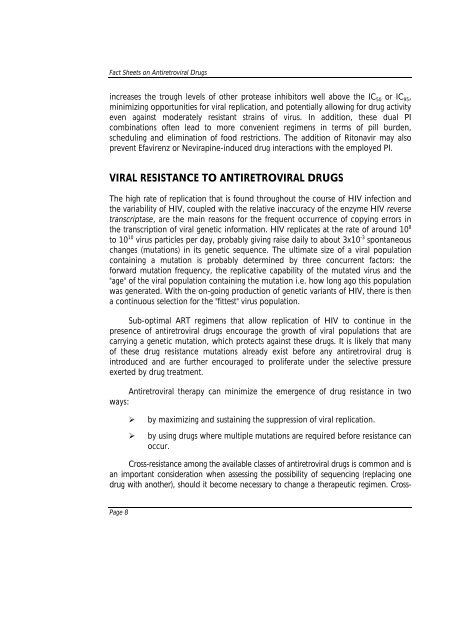Fact Sheets on Antiretroviral Drugs
Fact Sheets on Antiretroviral Drugs
Fact Sheets on Antiretroviral Drugs
You also want an ePaper? Increase the reach of your titles
YUMPU automatically turns print PDFs into web optimized ePapers that Google loves.
<str<strong>on</strong>g>Fact</str<strong>on</strong>g> <str<strong>on</strong>g>Sheets</str<strong>on</strong>g> <strong>on</strong> <strong>Antiretroviral</strong> <strong>Drugs</strong><br />
increases the trough levels of other protease inhibitors well above the IC 50 or IC 95,<br />
minimizing opportunities for viral replicati<strong>on</strong>, and potentially allowing for drug activity<br />
even against moderately resistant strains of virus. In additi<strong>on</strong>, these dual PI<br />
combinati<strong>on</strong>s often lead to more c<strong>on</strong>venient regimens in terms of pill burden,<br />
scheduling and eliminati<strong>on</strong> of food restricti<strong>on</strong>s. The additi<strong>on</strong> of Rit<strong>on</strong>avir may also<br />
prevent Efavirenz or Nevirapine-induced drug interacti<strong>on</strong>s with the employed PI.<br />
VIRAL RESISTANCE TO ANTIRETROVIRAL DRUGS<br />
The high rate of replicati<strong>on</strong> that is found throughout the course of HIV infecti<strong>on</strong> and<br />
the variability of HIV, coupled with the relative inaccuracy of the enzyme HIV reverse<br />
transcriptase, are the main reas<strong>on</strong>s for the frequent occurrence of copying errors in<br />
the transcripti<strong>on</strong> of viral genetic informati<strong>on</strong>. HIV replicates at the rate of around 10 8<br />
to 10 10 virus particles per day, probably giving raise daily to about 3x10 -3 sp<strong>on</strong>taneous<br />
changes (mutati<strong>on</strong>s) in its genetic sequence. The ultimate size of a viral populati<strong>on</strong><br />
c<strong>on</strong>taining a mutati<strong>on</strong> is probably determined by three c<strong>on</strong>current factors: the<br />
forward mutati<strong>on</strong> frequency, the replicative capability of the mutated virus and the<br />
"age" of the viral populati<strong>on</strong> c<strong>on</strong>taining the mutati<strong>on</strong> i.e. how l<strong>on</strong>g ago this populati<strong>on</strong><br />
was generated. With the <strong>on</strong>-going producti<strong>on</strong> of genetic variants of HIV, there is then<br />
a c<strong>on</strong>tinuous selecti<strong>on</strong> for the "fittest" virus populati<strong>on</strong>.<br />
Sub-optimal ART regimens that allow replicati<strong>on</strong> of HIV to c<strong>on</strong>tinue in the<br />
presence of antiretroviral drugs encourage the growth of viral populati<strong>on</strong>s that are<br />
carrying a genetic mutati<strong>on</strong>, which protects against these drugs. It is likely that many<br />
of these drug resistance mutati<strong>on</strong>s already exist before any antiretroviral drug is<br />
introduced and are further encouraged to proliferate under the selective pressure<br />
exerted by drug treatment.<br />
<strong>Antiretroviral</strong> therapy can minimize the emergence of drug resistance in two<br />
ways:<br />
Page 8<br />
� by maximizing and sustaining the suppressi<strong>on</strong> of viral replicati<strong>on</strong>.<br />
� by using drugs where multiple mutati<strong>on</strong>s are required before resistance can<br />
occur.<br />
Cross-resistance am<strong>on</strong>g the available classes of antiretroviral drugs is comm<strong>on</strong> and is<br />
an important c<strong>on</strong>siderati<strong>on</strong> when assessing the possibility of sequencing (replacing <strong>on</strong>e<br />
drug with another), should it become necessary to change a therapeutic regimen. Cross-









